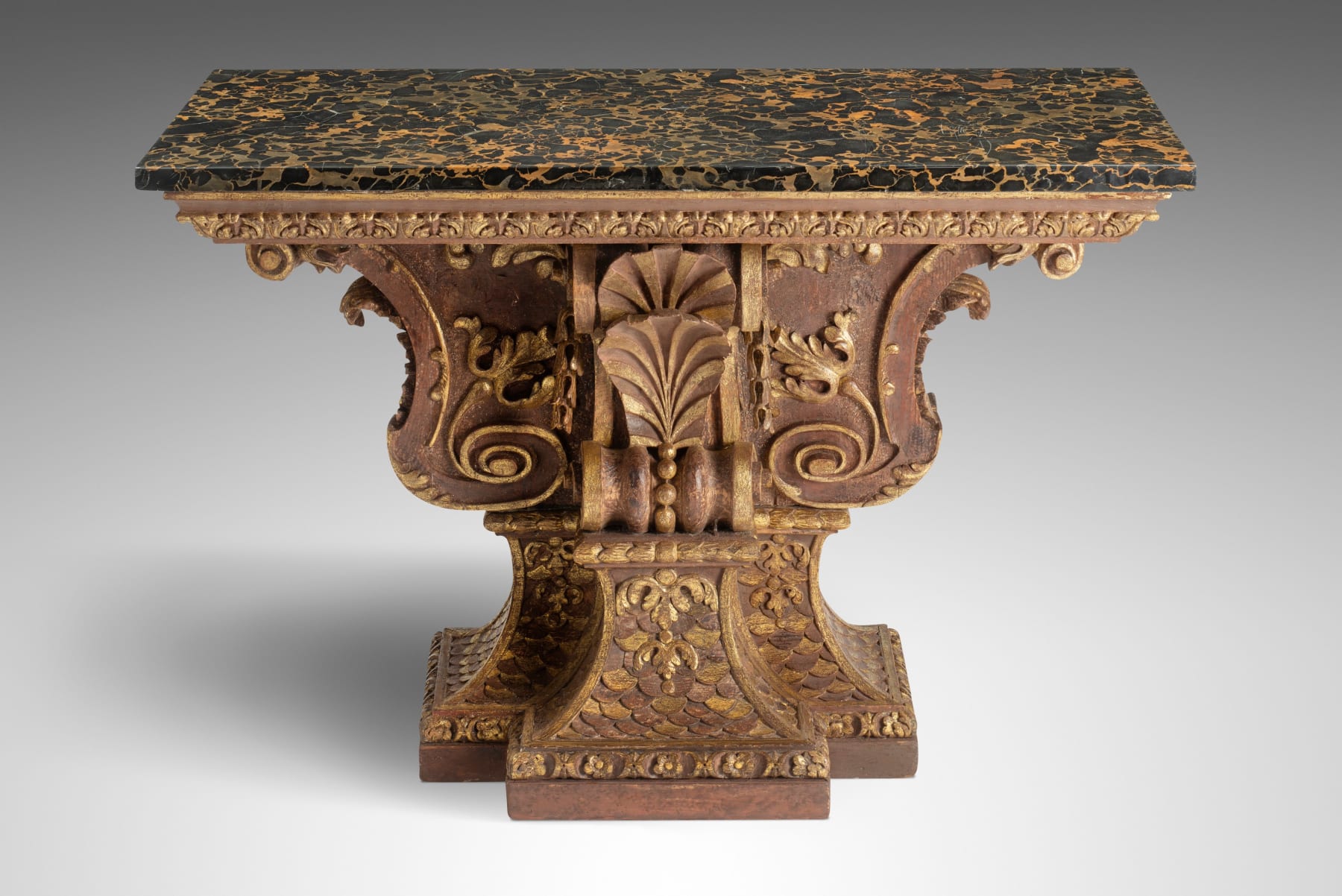A George II Simulated Mahogany and Parcel-gilt Pier Table, the design attributed to William Kent
ENGLAND, CIRCA 1733-35
79 x 119.5 x 61 cm
31 x 47 x 24 in
31 x 47 x 24 in
607a/7114
Further images
Provenance
Probably supplied to the Rt. Hon. Henry Pelham (d. 1754), eminent statesman and brother of the 1st Duke of Newcastle (d. 1768), for Esher Place, Surrey, and by descent with that house until it was bought in 1805 byJohn William Spicer (d. 1831) and by descent to his son
John William Gooch Spicer (1817 - 1883), who bought Spye Park, Chippenham, Wiltshire, in 1863, and by descent to his great-grandson
The late Captain F.F.F. Spicer, D.S.O., Spye Park, Christie's, London, 10 April 1975, lot 112
Collection of Mr and Mrs Tim Rock, The Old Rectory, Withington, Gloucestershire
Until sold Bruton Knowles, Cheltenham, circa 1990
With Ronald Lee
With Christopher Gibbs
Property of a Lady, sold Sotheby's, London, 5 June 2007, lot 148
Anonymous sale, Christies London, 4th June 2009.
Private Collection, Shropshire
Literature
Susan Weber (ed.) 'William Kent - Designing Georgian Britain', Published for BARD Graduate Center by Yale University Press, 2013 in conjunction with the exhibition of the same name, (the reverse of the table) illustrated p. 500
The rectangular portor marble top above an acanthus-carved moulded frieze, on a solid pedestal support with scrolled upper half carved with foliage and shells, on a breakfront imbricated lower half...
The rectangular portor marble top above an acanthus-carved moulded frieze, on a solid pedestal support with scrolled upper half carved with foliage and shells, on a breakfront imbricated lower half and a plinth base. A previous (but not original) white painted decoration has now been removed to reveal the original simulated mahogany and parcel gilt scheme below. The original gilding refreshed.
Esher Place:
When sold at Christie's in 1975, this table came from Spye Park, Chippenham, a house built in 1863-8 in a 'gabled Tudor' style to designs of William Burn, for J.W.G. Spicer, who had bought the estate in 1863. For sixty years before acquiring Spye Park (1805-1863), the Spicer family had owned Esher Place, Surrey, famed as a refuge of Cardinal Wolsey after his fall, and for its buildings designed by Kent. It seems almost certain that this table was brought to Spye Park in 1863 from Esher Place, for which it had been designed.
The Design:
Conceived as a George II 'Roman' sideboard-table in a style appropriate for a Palladian villa, the table's marble top is supported on a tripod frame of voluted trusses on altar-pedestals that are enriched with shells and dolphin-scales, evoking lyric poetry and the triumph of the nature deity Venus. Its Roman truss form, introduced in the 17th Century by the court architect Inigo Jones (d.1652) was popularised in the early 18th Century by Richard Boyle, 3rd Earl of Burlington, and his promotion of Isaac Ware's Some Designs of Mr Inigo Jones and others, 1731. In particular it was Burlington's protégé, the artist architect William Kent (d.1748), Master Carpenter to the King's Board of Works, who featured a related table, supported by voluted trusses and wrapped by Roman acanthus, in his Designs of Inigo Jones of 1727.
Henry Pelham was a subscriber to Isaac Ware's 1738 translation of Palladio's Four Books of Architecture, which included an acanthus-scrolled headpiece by Kent. Burlington and Kent also invented related Roman marble-topped tables, comprised of plinth-supported trusses, for Burlington's villa at Chiswick. One of that pair is now in the Victoria and Albert Museum (object no.:W.14 to :2-1971), and its pair remains at Chatsworth.
WILLIAM KENT AND HENRY PELHAM:
Having married in 1726, Henry Pelham bought a small estate at Esher in 1729, close to his brother at Claremont. At Esher, he employed Kent to alter the house that they found there, comprising the surviving gatehouse of William of Waynflete's 15th century palace, with two three-storey 18th century wings. Nicholas Thompson has written that 'Esher aimed to impress not so much by its size as by the taste of its owner'. Kent converted these additions in his own style of Tudor Gothic into a house for Pelham, with interiors in a mixture of styles, with much Gothick. A design by Kent for the saloon survives, with a ceiling embellished with shell-spandrels and a cove enriched with paired trusses, eminently suitable for this table.
Although only a very little of Kent's work at Esher survives to this day, enough evidence exists from drawings and the comments of Horace Walpole to confirm that internal decorations were in a variety of styles, as well as Tudor Gothic. Vardy published one chimneypiece pattern for Esher, in his Designs of Inigo Jones and William Kent, 1744, which combines a restrained Gothick chimneypiece with a recognisably Palladian overmantel. In William Kent - Designing Georgian Britain Dr. Susan Weber discusses this table: 'A white-painted and parcel-gilt pier table with marble top that came on the market in 2002 may be the only table identifiable from Kent's commission for Esher Place, Surrey, in the mid 1730s for Henry Pelham...The table came from the Spicer family who owned Esher from 1805.'
THE DECORATION OF THE TABLE
The simulated mahogany and parcel gilt decoration of this table is apparently unique. Presumably due to lack of suitable mahogany the table maker used water-based stain to achieve a mahogany like effect, which was then embellished with oil gilding. It appears the table was possibly originally intended to be free-standing because the back has been carved to a certain extent, but was then left unfinished as it is not visible when used against a wall. It is interesting to note that portor marble was one of Kent's favoured marbles. One of the Kent pier tables at Raynham Hall, along with the fireplace and hearth in the south corner morning room incorporate the same marble.












